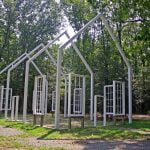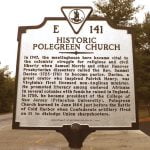Some of our past posts published here on This Day in Presbyterian History have given us portions on the life and ministry of Francis McKemie, in the context of the beginnings of the Presbyterian church in America. What informed Presbyterians know is that this founder of American Presbyterianism was ordained in Ireland as a Presbyterian minister, under the authority of an Irish Presbytery which itself was formed in 1642. But we are getting ahead of ourselves.
Under King James I, large numbers—literally tens of thousands—of Scottish Presbyterians emigrated in 1610 to the region now known as Northern Ireland. What they found was a barren land, laid waste by the Irish wars in the late 1500’s. These Scottish immigrants must have taken a deep breadth as they viewed their new surroundings, and wondered what they had gotten themselves into when they decided to leave Scotland. But James Hamilton and Hugh Montgomery, the two founding fathers of the Ulster Scot movement, knew that these Scot immigrants were just what was necessary to populate and transform the land. With courage and determination, they plowed, planted, and eventually built the region into an agricultural and industrial nation. They also rebuilt some 15 churches which had been destroyed in previous decades. These were a people who lived out their biblical faith; they were a people whose convictions equipped them to meet great challenges.
The first Presbyterian minister to Ulster was the Rev. Edward Brice who came over in 1613. Others would join him, even as the early church in Ireland would be more Prescopalian, to coin a word, than Presbyterian. Presbyterian ministers labored within the confines of Episcopal churches at first. Such a combination could not continue forever however, which was made clear on August 4, 1621, when the Five Articles of Perth were passed in the old country, and applied there and in Ulster. It was simply an attempt to conform Scottish worship to the Anglican pattern of worship. The attempt did not go well!
God’s Spirit was also at work during these times. There were three religious revivals which renewed the graces of Christ in believers, thus bringing God’s elect into the kingdom. These three revivals were known as the Stewarton Revival, the Six Mile Water Revival, and the Kirk O’Shotts Revival. Each in turn served to prepare Church members for some hard trials in later decades.
The first time of trial took place in 1639. The Black Oath was introduced in Ulster on May 21. It specifically rejected the National Covenant of Scotland, which had been signed in 1638. Those who were asked to sign the Black Oath were to reject the National Covenant, and swear loyalty to King Charles I. Some of the Ulster Scots signed the Black Oath, but most refused.
That trial continued on until October 23, 1641 when there was literally an “open season” for the persecution of Irish Protestants and Presbyterians carried out by Roman Catholics. This author chose not to amplify the gross details of the massacre, but it is horrible to the extreme. Estimates of those murdered were from 40,000 to 300,000. Finally, someone thought it best to call for military help from Scotland. Major General Robert Monro came with a Scottish army of 2500 soldiers to defend the harried residents of the Kirk.
But our post ends on a positive note, for from this Scottish army came the beginnings of the Presbyterian Church. Each Scottish regiment had a Presbyterian chaplain. Further, in each regiment, could be found what we would today call ruling elders. Then on Friday, June 10, 1642, in Carrisckfergus, Ireland, a meeting was held to constitute this Presbytery. Present were Presbyterian chaplains Hugh Cunningham, Thomas Peeples, John Baird, John Scott, and John Aird. Four other elders joined them to establish Sessions of Elders.
Rev. John Baird preached the first Presbytery sermon from Psalm 51:18, “By your favor do good to Zion, Build the walls of Jerusalem.” Rev. Thomas Peeples was elected as Stated Clerk, a position he held for the next 30 years. A flood of applications came from all of Ulster to join the Presbytery. By 1660, there would be 80 congregations, 70 ministers, 5 Presbyteries, and 100,000 members. And from them would come countless people immigrating to the land in which you and I live today.
Words to Live By:
What stands out to this author is how the Lord prepared His people by not only heaven-sent revivals of the church, but also through His preserving and sustaining care, in raising up His church despite terrible persecution of it. How we can be thankful that this same God is still the God of providence, who guides and guards His people today.

 To the locals, the outline of the white beams of the building is known as “the Ghost Church.” That is because it is neither a building or a monument, but only the outline of a church beside a road leading to Richmond, Virginia. Yet to those “in the know,” this site is both a historic site of religious and civil liberty.
To the locals, the outline of the white beams of the building is known as “the Ghost Church.” That is because it is neither a building or a monument, but only the outline of a church beside a road leading to Richmond, Virginia. Yet to those “in the know,” this site is both a historic site of religious and civil liberty. Fast forward to the time of the Civil Way in the land, to specifically 1864. General U.S. Grant had begun his eventual crushing Overland Campaign against General Robert E. Lee, of the Confederate States of America. The Union forces fought their way south until they faced each other at Totopotomoy Creek, Virginia. Right in the middle of the two armies was Polegreen Presbyterian Church. When Union sharpshooters occupied the simple building, Confederate artillery opened fire to dislodge this enemy force. One Southern gunner, William S White, of the Richmond Howitzers, fired the shot which set the building ablaze. He confessed later in his diary that his father had been baptized there.
Fast forward to the time of the Civil Way in the land, to specifically 1864. General U.S. Grant had begun his eventual crushing Overland Campaign against General Robert E. Lee, of the Confederate States of America. The Union forces fought their way south until they faced each other at Totopotomoy Creek, Virginia. Right in the middle of the two armies was Polegreen Presbyterian Church. When Union sharpshooters occupied the simple building, Confederate artillery opened fire to dislodge this enemy force. One Southern gunner, William S White, of the Richmond Howitzers, fired the shot which set the building ablaze. He confessed later in his diary that his father had been baptized there.![Rev. Francis Blanchard Hodge [1838-1905]](https://thisday.pcahistory.org/wp-content/uploads/2013/05/hodge_Francis_Blanchard.jpg)